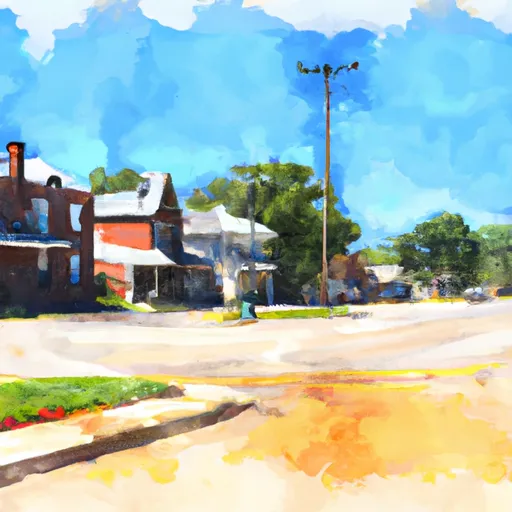-
 Snoflo Premium
Snoflo Premium
Get unlimited access to all our content
With no Ad interruptions! - Start Your Free Trial Login with existing account
Milburn
Eden Index
Climate
7.2
•
Recreation
2.0
•
Community
•
Safeguard
3.6/10

Milburn, Nebraska is a small town located in the Midwest region of the United States. The climate of Milburn is characterized by hot summers and cold winters. Summers are generally hot and humid, with temperatures often reaching into the high 80s and low 90s Fahrenheit. Winters, on the other hand, can be bitterly cold, with temperatures dropping below freezing and occasional snowfall.
Milburn is fortunate to be situated near several hydrological constituents, including rivers and lakes. The nearby Milburn River is a popular spot for fishing and boating enthusiasts. Its clear waters are home to a variety of fish species, including bass and catfish, providing ample opportunities for anglers.
Outdoor recreation opportunities in Milburn are abundant. The town is surrounded by picturesque landscapes, offering numerous hiking and biking trails for nature lovers. The region is also known for its hunting grounds, attracting enthusiasts from all over. Additionally, Milburn has several campgrounds and parks where families can enjoy picnicking, camping, and various outdoor activities.
In summary, Milburn, Nebraska experiences a climate with hot summers and cold winters. Its proximity to water bodies like the Milburn River provides excellent opportunities for fishing and boating. The town's scenic surroundings offer various outdoor recreation options such as hiking, biking, hunting, and camping.
What is the Eden Index?
The Snoflo Eden Index serves as a comprehensive rating system for regions, evaluating their desirability through a holistic assessment of climate health, outdoor recreation opportunities, and natural disaster risk, acknowledging the profound impact of these factors on livability and well-being.
Climate Health Indicator (CHI): 7.2
Milburn receives approximately
606mm of rain per year,
with humidity levels near 82%
and air temperatures averaging around
9°C.
Milburn has a plant hardyness factor of
5, meaning
plants and agriculture in this region thrive during a short period during spring and early summer. Most
plants will die off during the colder winter months.
By considering the ideal temperature range, reliable water supplies, clean air, and stable seasonal rain or snowpacks, the Climate Health Indicator (CHI) underscores the significance of a healthy climate as the foundation for quality living.
A healthy climate is paramount for ensuring a high quality of life and livability in a region, fostering both physical well-being and environmental harmony. This can be characterized by ideal temperatures, reliable access to water supplies, clean air, and consistent seasonal rain or snowpacks.
Weather Forecast
Streamflow Conditions
Loup
Area Rivers
Loup
Snowpack Depths
Loup
Reservoir Storage Capacity
Loup
Groundwater Levels
Recreational Opportunity Index (ROI): 2.0
The Recreational Opportunity Index (ROI) recognizes the value of outdoor recreational options, such as parks, hiking trails, camping sites, and fishing spots, while acknowledging that climate plays a pivotal role in ensuring the comfort and consistency of these experiences.
Access to outdoor recreational opportunities, encompassing activities such as parks, hiking, camping, and fishing, is crucial for overall well-being, and the climate plays a pivotal role in enabling and enhancing these experiences, ensuring that individuals can engage in nature-based activities comfortably and consistently.
Camping Areas
| Campground | Campsites | Reservations | Toilets | Showers | Elevation |
|---|---|---|---|---|---|
| Muny Park | 30 | 2,496 ft | |||
| Lexington City Park | None | 2,394 ft | |||
| Victoria Springs State Rec Area | 80 | 2,525 ft | |||
| Pressey State Wildlife Area | None | 2,429 ft | |||
| Morgan Municipal Park | 30 | 2,547 ft | |||
| Gallagher Canyon State Rec Area - Cozad | 25 | 2,664 ft | |||
| Tomahawk Municipal Park | None | 2,485 ft |
Catastrophe Safeguard Index (CSI):
The Catastrophe Safeguard Index (CSI) recognizes that natural disaster risk, encompassing floods, fires, hurricanes, and tornadoes, can drastically affect safety and the overall appeal of an area.
The level of natural disaster risk in a region significantly affects safety and the overall livability, with climate change amplifying these risks by potentially increasing the frequency and intensity of events like floods, fires, hurricanes, and tornadoes, thereby posing substantial challenges to community resilience and well-being.
Community Resilience Indicator (CRI):
The Community Resilience Indicator (CRI) recognizes that education, healthcare, and socioeconomics are crucial to the well-being of a region. The CRI acknowledges the profound impact of these elements on residents' overall quality of life. By evaluating educational resources, healthcare accessibility, and economic inclusivity, the index captures the essential aspects that contribute to a thriving community, fostering resident satisfaction, equity, and social cohesion.

